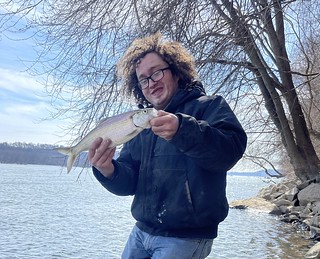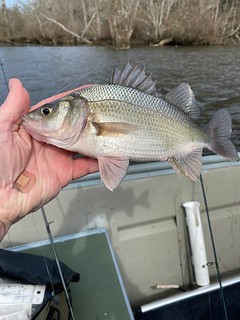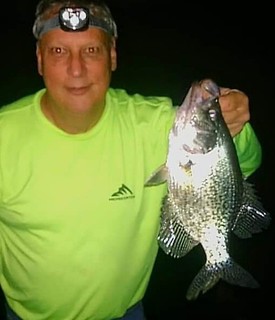
Olivia Hedges recently caught this fine-looking trout in a youth fishing area. Photo by Justin Hedges
The signs of spring are everywhere, and among them is the traditional opening day of Maryland trout season on Saturday, March 25 in many of the put-and-take trout management waters throughout the state. Trout anglers will be out fishing in their favorite waters and enjoying the generous stockings from Maryland Department of Natural Resources hatcheries.
Forecast Summary: March 22 – March 28:
Spring is here and its first full week will provide warm temperatures and lots of rain. This will help Chesapeake Bay waters continue to warm for gamefish such as yellow and white perch that are spawning or preparing to spawn in the next couple of weeks. Main Bay surface water temperatures have risen to the upper 40s. River temperatures have also climbed into the mid to upper 40s. Smaller streams and downwind areas on a sunny day will warm faster and often hold water temperatures in the upper 40s. Low salinity areas in this temperature range are prime locations for spawning perch as they move up from their wintering areas in the downstream portion of rivers.
Bay salinities are about normal. Expect average clarity for most Maryland portions of the Bay and rivers. Expect reduced water clarity from an algal bloom on the main Bay along the Tolchester area. To see the latest water clarity conditions, check Eyes on the Bay Satellite Maps.
Expect average flows for most Maryland rivers and streams. There will be above average tidal currents through Monday as a result of the new moon March 21-22.
As always, the best fishing areas could be further refined by intersecting them with underwater points, hard bottom, drop-offs, and large schools of baitfish.
For more detailed and up-to-date fishing conditions in your area of the Bay, be sure to check out Eyes on the Bay’s Click Before You Cast.
Upper Chesapeake Bay

Hickory shad, photo by Don Goff
Anglers are out casting large crankbaits and soft plastics for pre-spawn striped bass in the Susquehanna Flats catch-and-release area. The Department of Natural Resources website includes maps of which areas can be legally fished until March 31. Remember that releases should be done quickly to help large striped bass recover.
We had the first reported hickory shad of the year caught over the weekend by Lou Walden below the Conowingo Dam. Warming water temperatures will bring more of these fun catch-and-release fish to the lower Susquehanna and eventually Deer and Octoraro creeks.
Anglers can help DNR track these species’ populations by filling out an easy online angler survey. Visit the department’s website and search Volunteer Angler Survey, click on Shad Survey and tell us about your fishing trip. Your participation will help state biologists track the health of these species in our area, and we will include you on our annual Shad Volunteer Angler Survey Report at the end of the fishing season. A small prize will be awarded to the angler with the most log entries. Thank you to those who participated in the 2022 season, and we hope to see your fishing reports this year!
Anglers will be picking away at post-spawn yellow perch as these fish move downriver from their spawning areas. Lip-hooked minnows will be the best bait to use. The second run of white perch is now occurring in the spawning rivers and a piece of bloodworm on a small jig head or a bottom rig with a half-ounce sinker and a No. 4 hook. Look for deep holes or channels in the upper sections of the tidal rivers – this is where the yellow and white perch will be holding or moving through. The top half of the flood tide usually offers the best fishing for white perch.
A mix of blue and channel catfish are entertaining anglers in the upper Bay and the region’s tidal rivers this week. The catfish can be found in some of the deeper channels and holes, and will readily take a variety of baits. Cut menhaden and gizzard shad are at the top of the list for any angler looking for bait, but white perch, various chicken parts, and nightcrawlers will work as well.
Middle Bay

White perch, photo by Keith Lockwood
The white perch are making their second spawning runs up the Choptank River and Tuckahoe Creek this week, while post-spawn yellow perch are making their way down. The strong northwest winds caused extremely low tides late last week, which left many yellow perch egg masses hanging clear of the water and drying out, which is not a good thing. Yellow perch could be found below Greensboro on the Choptank and Stoney Point this past weekend as they head downriver. The yellow perch fishing could be best described as a slow pick for those using lip-hooked minnows close to the bottom in the deeper channel waters.
The white perch made up for any lack of yellow perch action. This is the second spawning run for white perch and they began making their move up the Choptank River on the afternoon flood tides in the area between Greensboro and Denton. They are in such abundance, with a high throwback ratio of perch under 9 inches, that anyone using grass shrimp would soon run out of bait. Pieces of bloodworm or a cut minnow on a small jig head, shad dart, or a simple one-hook bottom rig of a half-ounce sinker and a No. 4 hook are the ticket when the white perch are thick. Look for the white perch to be found from Greensboro to Red Bridges later this week.
Alewife herring could be seen in the upper Choptank and Tuckahoe this past weekend and hopefully the vanguard of the hickory shad are right behind them. The alewife herring, hickory shad, and blueback herring are all protected and are strictly a catch-and-release fishery. Small shad darts, tiny gold spoons, and brilliantly colored sinking flies are all good choices of lures.
A mix of channel and blue catfish are providing fishing action in the deeper channel areas of the upper Severn and Choptank rivers this week. The blue catfish are much more abundant in the Choptank from the Dover Bridge area upriver to the mouth of the Tuckahoe. Expect the blue catfish to continue to move upriver into April. Spawning striped bass have arrived in the Choptank River and catfish anglers should take care when using cut bait to fish for catfish. Circle hooks are recommended and many anglers fishing for catfish have learned they are a real asset. Any intentional catch-and-release fishing for striped bass in the Choptank River is strictly forbidden and can result in license suspensions and fines.
Catch-and-release fishing for pre-spawn striped bass is open in the middle Bay until March 31. Light-tackle anglers are looking for marks along steep channel edges and fishing deep with heavy jigs and large soft plastics. Drifting in the warm water discharge plume at the Calvert Cliffs Power Plant is a popular option. Others are trolling with large parachutes and bucktails dressed with sassy shads trolled in tandem along the shipping channel edges. Anglers can use no more than six lines when trolling, no stinger hooks are allowed, and all hook barbs must be removed or flattened. All fishing for striped bass in the main part of the Bay will be closed from April 1 until May 1. The DNR website can offer information on various closed and open areas for striped bass fishing.
Lower Bay

Eric Packard holds up a blue catfish from the tidal Potomac River. Photo courtesy of Eric Packard
Anglers looking for some catch-and-release striped bass action are finding it in the lower Bay this week. The strong winds we experienced last week have subsided and calmer seas are prevailing. Light-tackle anglers are jigging deep in the shipping channel, often at depths of 50 feet or more, with heavy jigs and large soft plastics. They are also fishing in the channel areas of the lower Potomac River. The large pre-spawn striped bass will feed on large menhaden or river herring if given the chance, so large baits are in order. Trolling is another option along the deep channel edges with large and heavy parachutes and bucktails dressed with equally large sassy shads. The 2023 striped bass catch-and-release season ends March 31. No more than six lines can be deployed when trolling, no stinger hooks are allowed, and all lures used must have the barbs removed or flattened.
Fishing for white perch is good this week as more move up the Nanticoke, Little Choptank, Pocomoke, and Wicomico rivers. Many of the tributaries flowing into the tidal Potomac also have white perch spawning runs. Pieces of bloodworm on a small jig head or a simple bottom rig with a No. 4 hook is the most popular way to fish in the deeper channel areas.
There are plenty of blue catfish to be found in the Sharpstown area of the Nanticoke River and in the tidal Potomac River. The catfish tend to be on the deep edges of the channels and can be caught with cut bait or various chicken parts.
Freshwater Fishing

Gary Simpson caught this nice crappie at Loch Raven Reservoir recently. Photo courtesy of Gary Simpson
Saturday, March 25 is a big day for put-and-take trout anglers across Maryland. Waters that have been closed to trout fishing will open at 5:30 a.m. for those hardy souls perched along river and pond banks. The stocking crews have been working overtime to place generous amounts of healthy trout in these waters for your angling pleasure. Be sure to check the DNR trout stocking website for the latest stockings, maps, and other trout fishing information.
Warming water temperatures are causing many freshwater species to become more active this first week of spring. At Deep Creek Lake and the upper Potomac River, smallmouth bass and walleye are entertaining anglers. Largemouth bass are becoming more aggressive in their feeding habits as they enter their pre-spawn bulk-up of body stores. They can often be found holding near structure in moderately deep waters – sunken wood, fallen treetops, rocks, bridge piers, emerging grass, and drop-offs are all good places to find them. Working wacky rigged or dropshot rigged soft plastics and stick worms is a good choice to entice a pickup. Casting grubs, crankbaits and jigs near structure is also a good choice. On sunny afternoons, the shallower waters are good places to cast spinnerbaits, soft plastics, jerkbaits, and lipless crankbaits.
Crappie are very active this week and can be found near structure in moderately deep waters. Using small marabou jigs or small minnows under a slip bobber is an excellent way to fish for them. Fallen treetops, marina docks, bridge piers, and most any kind of submerged structure are good places to look for them.
Chain pickerel are still very much in play for anglers casting paddletails and other lures near shoreline structure. Sunken wood is a favorite ambush hangout for chain pickerel. Bluegill sunfish are active this week and can be caught on a variety of small lures or a simple worm and bobber combination.
Atlantic Ocean and Coastal Bays

Photo by Monty Hawkins
There have been a few unconfirmed reports of the first flounder being caught in the back bay regions of Ocean City. Flounder are starting to show up at Wachapreague, so flounder should be showing up in the Ocean City area now or very soon.
Anglers are fishing for tautog at the inlet and Route 50 Bridge area this week. Most of the fish being caught are reported to be just shy of the 16-inch minimum, but there is plenty of action on sand fleas. Other anglers are casting soft plastic jigs around bridge and jetty structure and catching a few striped bass, but most are not making the 28-inch minimum.
The boats and anglers wishing to head out to the wreck and reef sites in search of tautog are finally seeing calmer seas. Many anglers have been catching large tautog, with some exceeding 20 pounds. These are true trophy fish, and most anglers respect how old they are and release them. White legger crabs tend to be the favored bait for these large fish, but other anglers are having good luck with jigs on smaller fish.
“I look at my yesterdays for months past and find them as good as a lot of yesterdays as anybody might want. I sit there in the firelight and see them all. The hours that made them were good, and so were the moments that made the hours. I have had responsibilities, work, dangers and pleasure, good friends, and a world without walls to live in.” – Beryl Markham, aviator and adventurer, from her memoir “West with the Night”
Maryland Fishing Report is written and compiled by Keith Lockwood, fisheries biologist with the Maryland Department of Natural Resources.
Click Before You Cast is written by Tidewater Ecosystem Assessment Director Tom Parham.
This report is now available on your Amazon Echo device — just ask Alexa to “open Maryland Fishing Report.”
